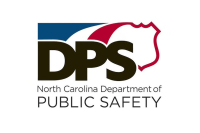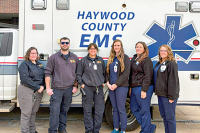Group forms to support Pisgah District
 When John Cottingham, then working as — in his words — a “stuffy, corporate lawyer,” walked into the Pisgah District Ranger Office to drop off a donation, he was surprised to learn that there actually wasn’t a way for the Pisgah National Forest to accept donations toward projects.
When John Cottingham, then working as — in his words — a “stuffy, corporate lawyer,” walked into the Pisgah District Ranger Office to drop off a donation, he was surprised to learn that there actually wasn’t a way for the Pisgah National Forest to accept donations toward projects.
“You could send a check to the federal government, and some of that would trickle down, but it wouldn’t be very satisfying,” Cottingham said.
But the Pisgah District, one of the most-visited in the nation, sure could use some help to accommodate its increasing use, Cottingham thought. So he decided to do something about it — organize The Pisgah Conservancy, a fundraising group aiming to support the Pisgah Ranger District.
“There’s been more and more usage over the years and harder usage in some ways — mountain bikers instead of hikers, for instance — at a time when federal support has been diminishing,” Cottingham said. “We think there is an opportunity for private funding to come in and help support the forest.”
Cottingham, who for his part enjoys hiking and camping, envisions The Pisgah Conservancy as having a similar relationship with the Pisgah Ranger District as Friends of the Smokies has with the Great Smoky Mountains National Park. He’s been talking to the Friends of the Smokies folks as part of his organizational efforts.
Discussion about what The Pisgah Conservancy could look like has been going on for quite a while, with the organization officially incorporating as a North Carolina nonprofit in October 2015 and receiving federal nonprofit status this year. Cottingham, the organization’s executive director, has one employee and an advisory council that pulls together representatives from groups including the Carolina Mountain Club, Trout Unlimited, the Fish and Wildlife Conservation Council and the International Mountain Bicycling Association, among others.
Related Items
Derek Ibarguen, district ranger, is thrilled that The Pisgah Conservancy is now a reality rather than just a concept.
“I’ve been here for about four and a half years, and as soon as I got here I thought, ‘We need an organization like this,’” he said.
It was after Cottingham walked in with the same idea, while also willing to put in the work, that things took off.
“It was great, really exciting to think of an idea, work on it and have it come to fruition,” Ibarguen said. “That’s one of the most satisfying things I’ve ever been involved in.”
The Pisgah Conservancy is currently in an organizational phase, not yet actively working on visible projects. It’s a fundraising organization, and raising money — whether through grants or donations — takes time. So does identifying and prioritizing projects.
“We’ve come up with some ideas that turned out to take longer working through bureaucratic type issues,” Cottingham said. “What we’re trying to do right now is fall back to more of a bite-sized, short-term project list.”
There’s no specific timeline yet, but Cottingham said that the group will start “having an impact on the ground this year.”
Project goals will likely be heavily recreation focused. Recreation is “increasing exponentially,” Cottingham said, “and the support for it isn’t.”
There are a number of dedicated volunteer groups who work on trail rehabilitation, and The Pisgah Conservancy won’t be looking to double up on existing efforts, Cottingham said. Rather, the group will be looking to address projects that go beyond the funding and organizational powers of those grassroots volunteer groups.
For example, say there’s a trail that was just poorly designed in the first place. Rather than have volunteer groups rebuild it again and again, the best thing to do would probably be to relocate it. But that requires going through the extensive process outlined in the National Environmental Protection Act, having various reviews completed and hiring a trail builder to construct the new route.
“That’s an example of the kinds of things that most of the organizations doing trail maintenance are not set up to do,” Cottingham said.
The Pisgah Conservancy might also, for example, busy itself installing bathrooms at heavily used trailheads to prevent people from answering the call of nature in concentrated areas. Other goals include addressing watershed improvement, invasive species eradication, habitat improvement, education and litter cleanup.
“I think this is a fantastic opportunity to engage with the community and capitalize on all the passion that’s in the area for the Pisgah District and move us toward a stronger ability to have a sustainable recreation program and protection and enhancement of our natural resources,” Ibarguen said.
Cottingham stressed that The Pisgah Conservancy is a fundraising organization, not an advocacy group, so it won’t weigh in on matters of policy, such as the still-unfolding forest management plan process. Work to craft the plan that will guide the Pisgah and Nantahala national forests for the next two decades began in 2014, and a final plan isn’t expected until 2017. Some aspects of the plan have sparked heated disagreement between different user groups.
Though the new organization won’t chime in on that discussion, Cottingham said, he believes it can help foster understanding between the dissenting parties.
“One of the things that I think has been advantageous about our group to this point is we’ve put a number of user groups around the same table in a very positive type of setting,” Cottingham said.
While those discussions don’t deal with the plan itself, they do include forest management in a more general sense.
“I think often they find there’s more commonality there than disagreement,” Cottingham said.
Get involved
The Pisgah Conservancy is looking for dollars and volunteers.
Currently, the group is raffling off a handmade L.T. Dondero bamboo fly rod — tickets are $10, $25 for three or $100 for 15 — with general donations also accepted.
Volunteers able to help with organizational tasks are currently being sought, with more hands-on volunteer jobs likely to be available in the future.
The Pisgah Conservancy is housed at the Cradle of Forestry in America, located along U.S. 276, about 36 miles south of Waynesville.
Donate, volunteer or enter the raffle at www.pisgahconservancy.org.
828.884.5713, ext. 214 or This email address is being protected from spambots. You need JavaScript enabled to view it..









